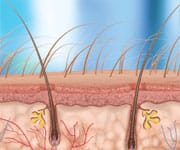Life Extension Magazine®

A hallmark outward sign of aging is thinning hair. Commercial products focus on the symptoms of thinning hair, rather than the cause.
Recent discoveries have uncovered compounds that, when combined, offer a diverse approach for improving the condition and appearance of the scalp —laying the foundation for healthier hair.
The scalp remains one of the most neglected parts of the body until the signs of dryness and itching appear—or, even worse, thinning hair and hair loss occur.
This article describes how a novel plant extract derived from the Argan tree gets to the root of thinning hair and hair loss by stimulating the activity of self-renewing dermal stem cells to alleviate a dry scalp and induce hair growth.
Discovery Of A Dermal Stem Cell Role
In 2009, a research team at the University of Toronto discovered a therapeutic application for restoring hair growth in those suffering from hair loss (alopecia)—and in those combatting the underlying causes that lead to the telltale signs of a damaged scalp. Their research was in the area of adult stem cells.
Adult stem cells have the ability to differentiate into tissue cell types with a specific function.1 The skin relies on a reservoir of active stem cells in both the epidermis (upper layer) and dermis (middle layer) to renew and repair itself, and also to enable proper wound healing.1-3
The location of dermal stem cells was only recently discovered by the Toronto-based research team.4
After conducting a series of studies, the researchers reported that cells localized at the base of the hair follicle (dermal papilla) expressed the stem cell marker Sox2 and exhibited the property to grow in colonies in the form of spheres, both characteristics of dermal stem cells. In addition to differentiating into fibroblasts that support dermal rejuvenation, these cells (referred to as skin-derived precursors, or SKPs) were also shown to generate hair follicle formation and stimulate hair growth in experimental mice. This evidence led the research team to conclude that skin-derived precursors are in fact “dermal stem cells that serve to induce hair morphogenesis and maintain the dermis.”4
Once scientists made this important discovery, the next step entailed identifying compounds that can improve the regenerative capacity of aging dermal stem cells. They soon discovered the answer in a rare plant: the Argan tree.
Topical Ingredients Revive Your Hair And Scalp
 |
- Procyanidin B-2 stimulates hair growth in balding men, leading one research team to recognize it “as a promising cure for male pattern baldness.”
- Biotin combats thinning hair.
- Copper supports hair follicles.
- Antioxidant-rich tea extracts quench excess free radicals that result in skin damage.
Activate And Vitalize Aging Dermal Stem Cells
Belonging to one of the oldest tree species in the world, the Argan tree grows in southwest Morocco where it adapts to extreme droughts and high temperatures. The plant’s survival under these diverse conditions speaks to the remarkable regenerative capacity of its stem cells.5 This prompted researchers to investigate whether these stem cells can activate our own aging dermal stem cells. Multiple preliminary studies indicate that they do.
For example, in an advanced cell culture technique, the presence of 0.1% Argan stem cell extract had beneficial effects on two important characteristics of dermal stem cells: It significantly enhanced the expression of the stem cell marker Sox2, and it increased the number of secondary spheres by 89% compared to untreated controls in aging dermal skin cells, thus improving their activity.6 This indicates that these newly activated dermal stem cells could then stimulate the formation of hair follicles and hair growth in humans.
In a clinical trial, human skin treated with Argan stem cell extract increased dermal density by nearly 13% compared to a placebo after eight weeks.6 This is important because aging is associated with a decreased number of fibroblasts that provide structural integrity to the dermis.7,8 The resulting reduction in dermal thickness gives way to a dry and damaged scalp.9 Thus, by increasing dermal density, Argan stem cell extract can help support a healthy scalp.
What You Need To Know
 |
Dermal Stem Cells Stimulate Hair Growth
- In 2009, a University of Toronto-based research team discovered a role for dermal stem cells in the dermal papilla (base of the hair follicle).
- Dermal stem cells induce hair follicle formation and hair growth in mice, which in turn raises their therapeutic potential to treat hair loss (alopecia) in humans.
- Scientists identified stem cells from the Argan tree that have been shown to activate dermal stem cells. This could stimulate the formation of hair follicles and hair growth in humans.
- Argan stem cells increase dermal density to support a healthy scalp.
- In addition, procyanidin B-2 and biotin support hair growth; copper supports hair follicles; and tea extracts protect the skin by fighting free-radical damage.
- When combined, these nutrients offer a multi-faceted approach for improving the health and appearance of the scalp—laying the foundation for healthy hair.
Four Additional Compounds That Support Healthy Hair
Two other nutrients, procyanidin B-2 and biotin, further encourage hair growth via different mechanisms than Argan stem cells. Additionaly, copper and tea extracts complement procyanidin B-2 and biotin’s hair-growing action by rejuvenating the scalp and hair from the inside out. Copper helps solidify the hair’s structure. Tea extracts quench excess free radicals that result in dryness, itchiness, and dullness of the scalp.
1. Procyanidins
Procyanidins are a subclass of flavonoids found at high concentrations in chocolate, apples, and grapes.10 Scientists have discovered that a particular form of procyanidin known as procyanidin B-2 favorably affects the natural hair growth cycle by reverting hair follicles from the telogen (resting) phase to the anagen (growth) phase.11 Procyanidin B-2 stimulates natural hair growth and has been found to increase hair density and average hair diameter in men.12,13
In a human study, researchers observed that 43 men with male pattern baldness who applied procyanidin B-2 twice daily to their scalp area for one year exhibited a significantly greater total number of hairs in a targeted scalp area than those who applied a placebo.12
In another double-blind, controlled clinical trial, balding men ranging in age from 30 to 57 applied either a topical application of procyanidin B-2 or a placebo twice daily to the scalp area for four months. At the study’s end, 78.9% of patients in the treatment group experienced increases in average hair diameter versus only 30% for the placebo group.13 Equally noteworthy, the procyanidin B-2 group also had a significantly higher ratio of hairs measuring 40 microns or more in diameter than the placebo group, demonstrating an improvement in hair thickness.13
These substantial hair-increasing effects led the team of researchers to recognize procyanidin B-2 as a promising treatment for male pattern baldness.13
2. Biotin
Biotin is a water-soluble vitamin whose deficiency has been shown to manifest itself as hair loss, suggesting that the micronutrient plays a vital role in supporting healthy hair.14
Oral supplementation of 1 mg per day of biotin for just a week led to the disappearance of biotin-deficiency symptoms, including alopecia.15
3. Copper
Dermal papilla (the base of the hair follicle) is the source of adult stem cells. Researchers observed that tripeptide-copper complex, a growth factor for various types of cells, stimulated the elongation of human hair follicles and of dermal papilla cells.16
4. Tea Extracts
The scalp is bombarded with free radicals on a daily basis, especially from UV exposure.17 As antioxidants produced within the body are depleted, excess free radicals begin to modify the scalp’s structure. This process causes a dry, damaged scalp.9
Green, black, white, and red tea extracts are brimming with potent antioxidants and anti-inflammatory compounds that protect the skin against the damaging effects of free radicals.16,18,19
Summary
The scalp is often the most neglected body part, yet it forms the foundation for healthy, beautiful hair.
A novel plant extract derived from the rare Argan tree enhances the regenerative capacity of aging dermal stem cells to induce hair follicle formation and stimulate hair growth, as well as improve dermal density to alleviate signs of a damaged scalp.
This extract has been formulated into a serum which, along with additional compounds, supports the health and appearance of the hair and scalp.
If you have any questions on the scientific content of this article, please call a Life Extension Wellness Specialist at 1-800-226-2370.
References
- Cerqueira MT, Marques AP, Reis RL. Using stem cells in skin regeneration: possibilities and reality. Stem Cells Dev. 2012 May;21(8):1201-14.
- Available at: http://www.ncbi.nlm.hin.gov/pubmed/22057442. Accessed March 21, 2014.
- Available at: http://www.ncbi.nlm.nih.gov/books/mbk26865. Accessed March 21, 2014.
- Biernaske J, Oaris M, Morozova O, et al. SKPs derive from hair follicle precursors and exhibit properties of adult dermal stem cells. Cell Stem Cell. 2009 Dec;5(6):610-23.
- Abassi A, Khalid N, et al. Physicochemical characteristics, nutritional properties and health benefits of argan oil: a review. Crit Rev Food Sci Nutr. 2014; 54(11):1401-14.
- Available at: http://www.protectingredia.com/downloads/Dermal stem cells are the target of the latest treatments for deep-seated skin regeneration. CosmeticsDesign Feb 2012.pdf. Accessed March 21, 2014.
- Guin AG, Kornilova NK, Vasilieva OV, Petrov VV. Age-related changes in proliferation, the numbers of mast cells, eosinophils, and cd45-positive cells in human dermis. J Gerontol A Biol Sci Med Sci. 2011 Apr;66(4):385-92.
- Varani J, Dame MD, Rittie L, Fligiel SE, Kang S, Fisher GJ, Voorhees JJ. Decreased collagen production in chronologically aged skin: roles of age-dependent alteration in fibroblast function and defective mechanical stimulation. Am J Pathol. 2006 Jun:168(6):1861-8.
- Gan D, Sinclair R. Aging of the scalp and age-related disorders of the scalp. In:Trube RM, ed. Aging hair. Apringer Heidelberg Dordrecht Londa New York; 2010:167-171.
- Hammerstone JF, Lazarus SA, Schmitz HH. Procyanidin content and variation in some commonly consumed foods. J Nutr. 2000 Aug;130:2086S-92S.
- Takahashi T, Kamiya T, Hasegawa A, Yokoo Y. Procyanidin oligomers selectively and intensively promote proliferation of mouse hair epithelial cells in vitro and activate hair follicle growth in vivo. J Invest Dermatol. 1999 Mar;112(3):310-6.
- Takahashi T, Kamimura A, Kagoura M, et al. Investigation of the topical application of procyanidin oligomers from apples to identify their potential use as hair-growing agent. J Cosmet Dermatol. 2005 Dec;4(4):245-9.
- Takahashi T, Kamimura A, Kagoura M, et al. The first clinical trial of topical application of procyanidin B-2 to investigate its potential as a hair grrowing agent. Phytother Res. 2001 Jun;15(4):331-6.
- Tosti A, Piraccini BM, Sisti A, Duqu-Estrada B. Hair loss in women. Minerva Ginecol. 2009 Oct;61(5):445-52.
- Higuchi R, Noda E, et al. Biotin deficiency in an infant fed with amino acid formula and hypoallergenic rice. Acta Paediatr. 1996 Jul;85(7):872-4.
- Pyo HK, Yoo HG, et al. The effect of tripeptide-copper complex on human hair growth in vitro. Arch Pharm Res. 2007 Jul;30(7):834-9.
- Trüeb RM . Oxidative stress in ageing of hair. Int J Trichology. 2009 Jan;1(1):6-14.
- Camouse MM, Domingo DS, et al. Topical application of green and white tea extracts provides protection from solar-simulated ultraviolet light in human skin. Exp Dermatol. 2009 Jun;18(6):522-6.
- Reni ML. Free radical scavenging properties of antioxidants like Beta-carotene, Lutein, Lucopene, Catachins, Cryptoxanthings, Zoochemicals and various indoles and flavonoids. JMPAS. 2013; 4:52-62.

